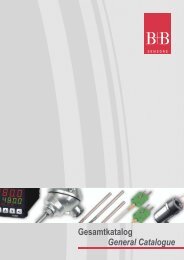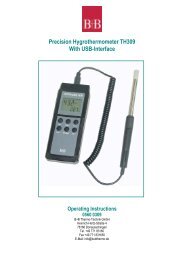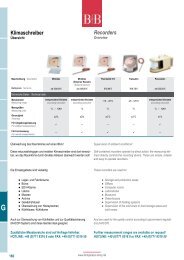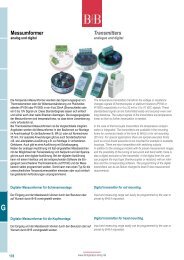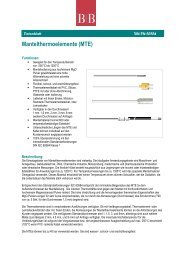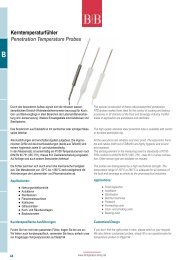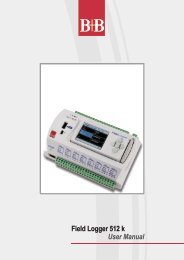Technische Erläuterung zu geraden ... - Temperatur-Shop
Technische Erläuterung zu geraden ... - Temperatur-Shop
Technische Erläuterung zu geraden ... - Temperatur-Shop
Create successful ePaper yourself
Turn your PDF publications into a flip-book with our unique Google optimized e-Paper software.
B<br />
<strong>Technische</strong> <strong>Erläuterung</strong> <strong>zu</strong> <strong>geraden</strong> Thermoelementen<br />
Anhaltswerte für die Verwendung <strong>zu</strong> <strong>geraden</strong> Thermoelementen allgemein<br />
max. Lufttemperatur<br />
°C<br />
38<br />
Werkstoff beständig in Atmosphäre stickstoffhaltig<br />
sauerstoffarm<br />
oxidierend reduzierend<br />
www.temperatur-shop.de<br />
Aufkohlung<br />
550 St 35.8 (1.0305) gering gering mittel ------<br />
850 X10CrAI18 (1.4571) sehr groß mittel gering mittel<br />
1200 X10CrAI24 (1.4762) sehr groß groß gering mittel<br />
1200 X15CrNiSi2520 (1.4841) gering gering groß gering<br />
1200 X15NiCr6015 (1.4867) gering gering groß gering<br />
Anlassöfen St 35.8 (1.0305)<br />
Härte- und Glühöfen Atmosphäre oxidierend, schwefel- und kohlenstoffhaltig: X10CrAI18 (1.47452) und X10CrAI24 (1.4762)<br />
Chemisch aggresive Dämpfe: X10CrNiTi189 (1.4541) oder X10CrNiMoTi1810 (1.4571)<br />
Nitrieröfen Atmosphäre stickstoffhaltig, sauerstoffarm: X15CrNiSi2520 (1.4841)<br />
Salzschmelzen Salpeter bis 550°C Reineisen M2<br />
Cyan bis 950°C Reineisen M2<br />
chloridhaltig 600 bis 1050°C X10CrAI24 (1.4762)<br />
Metallschmelzen Aluminium, Magnesium bis 700°C GG-22 (0.6022)<br />
magnesiumhaltiges Aluminium bis 700°C Reineisen M2<br />
Lagermetall bis 600°C St 35.8 (1.0305), emailliert<br />
Blei bis 600°C St 35.8 (1.0305) oder GG-22 (0.6022)<br />
Zink bis 480°C St 35.8 (1.0305), emailliert<br />
bis 600°C Reineisen M2<br />
Zinn bis 600°C St 35.8 (1.0305), emailliert<br />
Kupfer bis 1250°C X10CrAI24 (1.4762)<br />
Messing bis 900°C X10CrAI24 (1.4762)<br />
Da die Einsatzbedingungen und Betriebsverhältnisse sehr unterschiedlich sind, sind diese Angaben nur Anhaltswerte.<br />
Schutzmaßnahmen: Die Gebrauchsfähigkeit der Schutzrohre aus unlegiertem Stahl kann durch einen Über<strong>zu</strong>g von Feueremaille oder durch einen Schutzanstrich in ihrer Haltbarkeit<br />
verlängert werden. Da bei Schmelzen der stärkste Angriff an der Grenzfläche erfolgt, können die Rohre durch öfteres Wechseln der Eintauchtiefe, durch eine Muffe oder durch<br />
eine Bandage aus Glasfaserband mit Wasserglas geschützt werden.<br />
Anhaltswerte für die Verwendung von keramischen Schutzrohrwerkstoffen<br />
Pythagoras Typ C 610* Alle Gase, die frei von Flusssäure- und Alkalidämpfen sind bis 1500°C<br />
Alsint 99,7 Typ C799* Alkalidämpfe (Glasschmelz- und Steinzeugbrennöfen) bis 1600°C<br />
Glasschmelzen bis 1500°C<br />
Sillimantin 60 Typ C 530* alle Gase, wenn gasdichtes keramisches Innenrohr verwendet wird bis 1600°C<br />
Die <strong>Temperatur</strong>wechselbeständigkeit ist bei gasdichten keramischen Rohren, wie Typ C 610 und Typ C799, mittelmäßig. Bei hoher <strong>Temperatur</strong> ist wegen der geringen Biegefestigkeit<br />
ein senkrechter Einbau vor<strong>zu</strong>sehen.<br />
<strong>Temperatur</strong>wechselbeständigkeit Dichtigkeit Zulässige Dauertemperatur<br />
Pythagoras Typ C 610* mittel bis gut gasdicht 1500°C<br />
Alsint 99,7 Typ C799* mittel gasdicht 1600°C<br />
Sillimantin 60 Typ C 530* sehr gut porös 1600°C<br />
* Typ C 799, Typ C 610 und Typ C 530 stehen für die ehemaligen DIN-Bezeichnungen Ker 710, Ker 610 und Ker 530
Technical Notes Straight Thermocouples in general<br />
Reference values for the use of metallic materials for protection tubes<br />
Max. air temperature<br />
°C<br />
Material Resistance in atmosphere Nitrogenous<br />
poor in oxygen<br />
Oxydating Reducing<br />
www.temperatur-shop.de<br />
Carburization<br />
550 St 35.8 (1.0305) poor poor good ------<br />
850 X10CrAI18 (1.4571) excellent good poor good<br />
1200 X10CrAI24 (1.4762) excellent very good poor good<br />
1200 X15CrNiSi2520 (1.4841) poor poor very good poor<br />
1200 X15NiCr6015 (1.4867) poor poor very good poor<br />
Tempering Furnaces St 35.8 (1.0305)<br />
Casehardening and<br />
heating furnaces<br />
Oxidising atmosphere, sulfurous and carbonic: X10CrAI18 (1.47452) und X10CrAI24 (1.4762)<br />
Chemically aggressive steam: X10CrNiTi189 (1.4541) oder X10CrNiMoTi1810 (1.4571)<br />
Nitration furnaces Atmosphere nitrogenous, poor in oxygen: X15CrNiSi2520 (1.4841)<br />
Salt melting Salpeter up to 550°C Pure iron M2 M2<br />
Cyan up to 950°C Pure iron M2 M2<br />
Chloride 600 up to 1050°C X10CrAI24 (1.4762)<br />
Metal smelting Aluminium, Magnesium up to 700°C GG-22 (0.6022)<br />
Aluminium with magnesium up to 700°C Pure iron M2 M2<br />
Bearing Metal up to 600°C St 35.8 (1.0305), emailliert<br />
Lead up to 600°C St 35.8 (1.0305) oder GG-22 (0.6022)<br />
Zinc up to 480°C St 35.8 (1.0305), emailliert<br />
up to 600°C Pure iron M2 M2<br />
Tin up to 600°C St 35.8 (1.0305), emailliert<br />
Copper up to 1250°C X10CrAI24 (1.4762)<br />
Brass up to 900°C X10CrAI24 (1.4762)<br />
As the applications and operating conditions vary, these specifications are only reference values.<br />
Protective arrangements: The life time of the protection tubes made of carbon steel can be prolonged by coating a vitreous-enamelling or by a protective coating. As melting attacks<br />
the surface the most, the tubes can be protected by repeated changes of the immersion depth, by a muffle or a bandage made of fiber glass ribbon with water glass.<br />
Reference values for the use of ceramic protection tubes<br />
Pythagoras Type C 610* All gases, free from hydrofluoric acid and alkalic steams up to 1500°C<br />
Alsint 99,7 Type C799* Alkali steams (glass melting and stoneware furnace) up to 1600°C<br />
Glass melting up to 1500°C<br />
Sillimantin 60 Type C 530* All gases, if a gastight ceramic inner tube is used up to 1600°C<br />
The resistance to sudden changes of temperature of ceramic tubes impermeable to gas, like type C610 and type C799, is good. At high temperatures a vertical installation is<br />
required due to the poor rigidity.<br />
Resistance to sudden<br />
temperature changes<br />
Density Permanent temperature permitted<br />
Pythagoras Type C 610* good impermeable to gas 1500°C<br />
Alsint 99,7 Type C799* good impermeable to gas 1600°C<br />
Sillimantin 60 Type C 530* very good porous 1600°C<br />
* Type C 799, type C 610 and type C 530 stand for the former DIN specifications Ker 710, Ker 610 und Ker 530<br />
39<br />
B
B<br />
<strong>Technische</strong> <strong>Erläuterung</strong>en Thermoelemente<br />
Technical Notes Thermocouples<br />
<strong>Technische</strong> <strong>Erläuterung</strong>en Thermoelemente Technical Notes Thermocouples<br />
Funktion und Aufbau von Thermoelementen<br />
Function and construction of thermocouples<br />
Thermoelemente werden durch eine elektrisch leitende Verbindung zweier verschiedener<br />
Metalle (Legierungen) gebildet. An der Verbindungsstelle entsteht eine temperaturabhängige<br />
Kontaktspannung. Diese Kontaktspannung (Thermospannung) hängt von<br />
den beiden Legierungen und der <strong>Temperatur</strong>differenz zwischen der Verbindungsstelle<br />
(Messstelle) und den offenen Enden (Anschlussstelle) ab. Die Enden müssen mit<br />
identischen Legierungen (Thermoleitung) oder mit Legierungen, die die gleichen thermoelektrischen<br />
Eigenschaften (Ausgleichsleitung) haben wie die Thermoelementdrähte,<br />
weitergeführt werden, bis <strong>zu</strong> einer Vergleichsmessstelle bekannter <strong>Temperatur</strong>. Bei den<br />
meisten Auswertegeräten mit einem Thermoelementeingang wie Reglern, Anzeige- oder<br />
Registriergeräten ist die Vergleichsstelle bereits integriert.<br />
Farbkennzeichnung für Thermoelemente Color Codes for Thermocouples<br />
60<br />
www.temperatur-shop.de<br />
Thermocouples are created by an electrically conductive connection between two different<br />
metals (alloys). A temperature dependant voltage arise at the connection of the<br />
two metal wires. At the connection results a temperature dependent contact potential.<br />
This contact voltage, the thermo electrical potential, depends on the composition of the<br />
two alloys and on the temperature difference between the connection gauge and the<br />
open ends (connector plug). The ends have to be continued with identical alloys (thermo<br />
cable) or with alloys, which have the same thermo electrical specifications (compensation<br />
cable) as the Thermocouples wires until a zone of known temperature (reference<br />
junction). Most of the measuring instruments with an input for Thermocouples, like<br />
controllers, indicators or registration equipment have already this reference junction<br />
included.<br />
Element<br />
Typ Norm<br />
Mantel<br />
Plus Schenkel<br />
Minus Schenkel<br />
Element<br />
Type Standard<br />
Sheath<br />
+ Wire<br />
- Wire<br />
Cu-CuNi T IEC 584 braun brown braun brown weiß white<br />
Fe-CuNi J IEC 584 schwarz black schwarz black weiß white<br />
NiCr-Ni K IEC 584 grün green grün green weiß white<br />
NiCrSi-NiSi N IEC 584 rosa pink rosa pink weiß white<br />
NiCr-CuNi E IEC 584 violett purple violett purple weiß white<br />
Pt10Rh-Pt S IEC 584 orange orange orange orange weiß white<br />
Pt13Rh-Pt R IEC 584 orange orange orange orange weiß white<br />
Fe-CuNi L DIN 43710 blau blue rot red blau blue<br />
Cu-CuNi U DIN 43710 braun brown rot red braun brown<br />
Grenzabweichungen für Thermoelemente nach IEC 584-2 Limit Deviation for Thermocouples according IEC 584-2<br />
Thermoelement<br />
Klasse 1<br />
Klasse 2<br />
Thermocouples<br />
class 1<br />
class 2<br />
± 0,5°C oder or (0,004 x ITI) °C ±1°C oder or (0,0075 x ITI) °C<br />
Typ T -40°C … 350°C -40°C … 350°C<br />
± 1,5°C oder or (0,004 x ITI) °C ± 2,5°C oder or (0,0075 x ITI) °C<br />
Typ E -40°C … 800°C -40°C … 900°C<br />
Typ J -40°C … 750°C -40°C … 750°C<br />
Typ K -40°C … 1000°C -40°C … 1200°C<br />
Typ N -40°C … 1000°C -40°C … 1200°C<br />
± 1°C oder or [+0,003 (ITI-1100)] °C ± 1,5°C oder or (0,0025 x ITI) °C<br />
Typ R / S 0°C … 1600°C 0°C … 600°C<br />
Typ B -- 600°C … 1700°C<br />
Die <strong>zu</strong>lässigen Grenzabweichungen sind in Grad Celsius sowie in Prozent angege- The permissible limit deviations are mentioned in °C as well as in percentage.<br />
ben. Es gilt der jeweils höhere Wert. Die Toleranzen der Klassen 1 und 2 gelten in The higher value is valid. The tolerances of class 1 and 2 are valid in the indicated<br />
den angegebenen <strong>Temperatur</strong>bereichen. ITI = Betrag der <strong>Temperatur</strong> in °C<br />
ranges. ITI= <strong>Temperatur</strong>e value in °C
<strong>Technische</strong> <strong>Erläuterung</strong>en Thermoelemente - Grundwerte<br />
Technical Notes Thermocouples - Core Value<br />
°C<br />
Typ U Typ T Typ L Typ J Typ E Typ K Typ N Typ S Typ R Typ B Typ C Typ D<br />
-100 -3,400 -3,378 -4,750 -4,632 5,237 -3,553 -2,407<br />
-50 -1,850 -1,819 -2,510 -2,431 -2,787 -1,889 -1,268<br />
0 0,000 0,000 0,000 0,000 0,000 0,000 0,000 0,000 0,000 0,000 0,000 0,000<br />
50 2,050 2,035 2,650 2,585 3,047 2,022 1,339 0,299 0,296 0,002 0,117 0,525<br />
100 4,250 4,277 5,370 5,268 6,317 4,095 2,774 0,645 0,647 0,033 0,334 1,145<br />
150 6,620 6,702 8,150 8,008 9,787 6,137 4,301 1,029 1,041 0,092 0,642 1,840<br />
200 9,200 9,286 10,950 10,777 13,419 8,137 5,912 1,440 1,468 0,178 1,036 2,602<br />
250 11,980 12,011 13,750 13,553 17,178 10,151 7,596 1,873 1,923 0,291 1,509 3,426<br />
300 14,900 14,860 16,560 16,325 21,033 12,207 9,340 2,323 2,400 0,431 2,055 4,290<br />
350 17,920 17,816 19,360 19,089 24,961 14,292 11,135 2,786 2,896 0,596 2,666 5,186<br />
400 21,000 20,869 22,160 21,846 28,943 16,395 12,972 3,260 3,407 0,786 3,339 6,128<br />
450 24,150 25,000 24,607 32,960 18,513 14,844 3,743 3,933 1,002 4,066 7,108<br />
500 27,410 27,850 27,388 36,999 20,640 16,744 4,234 4,471 1,241 4,844 8,097<br />
550 30,800 30,750 30,210 41,045 22,772 18,668 4,732 5,021 1,505 5,666 9,088<br />
600 34,310 33,670 33,096 45,085 24,902 20,609 5,237 5,582 1,791 6,529 10,093<br />
650 36,640 36,066 49,109 27,022 22,564 5,751 6,155 2,100 7,427 11,107<br />
700 39,720 39,130 53,110 29,128 24,526 6,274 6,741 2,430 8,357 12,129<br />
750 42,920 42,283 57,083 31,214 26,491 6,805 7,339 2,782 9,315 13,157<br />
800 46,220 45,498 61,022 33,277 28,456 7,345 7,949 3,154 10,296 14,184<br />
850 49,630 64,924 35,314 30,417 7,892 8,570 3,546 11,297 15,208<br />
900 53,140 51,875 68,783 37,325 32,370 8,448 9,203 3,957 12,315 16,225<br />
950 72,593 39,310 34,315 9,012 9,848 4,386 13,347 17,243<br />
1000 57,942 76,358 41,269 36,248 9,585 10,503 4,833 14,389 18,251<br />
1050 43,202 38,169 10,165 11,170 5,297 15,439 19,246<br />
1100 63,777 45,108 40,076 10,754 11,846 5,777 16,493 20,241<br />
1150 46,985 41,966 11,348 12,532 6,273 17,550 21,216<br />
1200 48,828 43,836 11,947 13,224 6,783 18,607 22,189<br />
1250 50,633 45,682 12,550 13,922 7,308 19,662 23,131<br />
1300 52,398 47,502 13,155 14,624 7,845 20,713 24,063<br />
1350 54,125 13,761 15,329 8,393 21,757 24,993<br />
1400 14,368 16,035 8,952 22,793 25,912<br />
1450 14,973 16,741 9,519 23,819 26,819<br />
1500 15,576 17,445 10,094 24,833 27,706<br />
1550 16,176 18,146 10,674 25,834 28,582<br />
1600 16,771 18,842 11,257 26,821 29,448<br />
1650 17,360 19,533 11,842 27,791 30,299<br />
1700 17,942 20,215 12,426 28,744 31,130<br />
1750 18,504 20,878 13,008 29,678 31,946<br />
1800 13,585 30,591 32,745<br />
1850 31,484 33,526<br />
1900 32,354 34,287<br />
1950 33,201 35,029<br />
2000 34,023 35,751<br />
2050 34,818 36,448<br />
2100 35,587 37,108<br />
2150 36,328 37,738<br />
2200 37,039 38,339<br />
2250 37,720 38,896<br />
2300 38,369 39,395<br />
2350 39,845<br />
2400 40,253<br />
mV<br />
www.temperatur-shop.de<br />
61<br />
B
B<br />
<strong>Technische</strong> Daten Messwiderstände Pt100<br />
<strong>Technische</strong> Daten Messwiderstände Pt100<br />
Pt-Widerstandsfühler<br />
Die genaueste Messung der <strong>Temperatur</strong> wird mit Platin-Widerstandsfühlern durchgeführt. Mit Pt100 z. B. (Platin-Widerstandsfühler mit 100 Ohm Nennwiderstand bei 0°C) können<br />
<strong>Temperatur</strong>en im Bereich von -254,3°C bis +850°C gemessen werden. Mit neuartigen Platinfühlern können sogar <strong>Temperatur</strong>en bis 1100°C gemessen werden. Die extreme<br />
Genauigkeit, die kleiner 0,03°C bei 0°C, je nach verwendetem Sensor, sein kann, wird einmal durch die Messmethode, aber auch durch das Material Platin selbst erreicht. Platinmesswiderstände<br />
haben eine ausgezeichnete Langzeitstabilität, hervorragende Reproduzierbarkeit und Austauschbarkeit. Sie sind unempfindlich gegen Korrosion. Die Messung<br />
beruht darauf, dass sich der elektrische Widerstand des Platins über einen großen <strong>Temperatur</strong>bereich nahe<strong>zu</strong> proportional <strong>zu</strong>r <strong>Temperatur</strong> ändert. Die Widerstandsänderung des<br />
Platins in Abhängigkeit von der <strong>Temperatur</strong> beträgt durchschnittlich 0,385 Ω/K. Durch geeignete Messverfahren kann die Nicht-Linearität der Widerstand vs. <strong>Temperatur</strong> ausgeglichen<br />
werden.<br />
Anschluss von Pt-Widerstandsfühlern<br />
Die Messung der <strong>Temperatur</strong> mit Pt - Messfühlern beruht auf der Widerstandsänderung des Platins bei <strong>Temperatur</strong>änderung. Diese Widerstandsänderung wird elektronisch durch<br />
Einspeisen eines konstanten Stromes im Pt-Widerstand gemessen. Anschließend wird der Spannungsabfall über dem Widerstand ( U (Volts) = R (Ohms) x I (Amperes)) gemessen.<br />
Aufgrund der Selbsterwärmung des Sensors, welche durch das Ohmsche Gesetz auftritt, muss der Messstrom so klein wie möglich gehalten werden (in der Praxis zwischen 1µA<br />
und 1 mA). Ausgehend vom gemessenen Widerstand, wird die <strong>Temperatur</strong> in einer inversen Polynomial Berechnung ermittelt. Pt -<strong>Temperatur</strong>fühler werden in 2-, 3- oder 4-Leitertechnik<br />
angeschlossen. Da die Widerstandsänderung bei Pt -Widerständen nur ca. 0,385 Ω/K beträgt, müssen besonders bei 2-Leiter-technik auch die Zuleitungswiderstände<br />
berücksichtigt werden. Um den Einfluss der Zuleitungswiderstände <strong>zu</strong> vermeiden, benutzt man idealerweise die 4-Leiter-technik.<br />
Normen<br />
Platinmesswiderstände wurden nach ITS-90 als Primäre <strong>Temperatur</strong>skala definiert. Weltweit gelten die IEC 751 Norm und der Britisch Standard von 1964 BS 1904/JISC 1604.<br />
Nach IEC 751 lassen sich die Widerstände aller Platinsensoren durch folgende Formeln berechnen:<br />
R(t) = R(0°C) (1+At+Bt 2 +C (t-100)t 3 ) für -200°C bis 0°C<br />
R(t) = R(0°C) (1+At+Bt 2 ) für 0°C bis 850°C<br />
A = 3,9083x10 -3 / °C -1 B = -5,775x10 -7 / ° C -2 C= -4,183x10 -12 / °C -4<br />
Spezifikationen Pt100<br />
Messfühler<br />
Nennwiderstand bei 0°C<br />
Toleranzen:<br />
eingeengte Toleranzen<br />
andere Standards<br />
Messbereich<br />
Thermische Ansprechzeit T90<br />
Langzeitstabilität<br />
Empfohlener Messstrom<br />
Eigenerwärmung<br />
Schock und Vibration<br />
Wicklungsart<br />
Kalibrierung<br />
Normen<br />
Optionen<br />
62<br />
Pt100 (Platinmesswiderstand, gewickelt oder als Schicht) in oder auf Keramikkörper<br />
100,00 Ohm<br />
Klasse A: ∆ t = ± (0,15°C + 0,002xltl)<br />
Klasse B: ∆ t = ± (0,3 °C + 0,005xltl)<br />
1/3, 1/5, 1/10 DIN von Klasse B<br />
BS 1904, BS2G. 148, JIS C 1604<br />
Dünnschichttechnologie -70...+500°C<br />
Keramik gewickelt -200...+600°C<br />
bis +850°C auf Anfrage<br />
Die thermische Ansprechzeit ist abhängig vom Durchmesser des Keramikkörpers und damit für jeden Sensortyp unterschiedlich. Die<br />
Ansprechzeit in bewegtem Wasser kann zwischen 0,03 Sekunden und 2,2 Sekunden liegen.<br />
Besser als ± 0,05 % / Jahr<br />
Bereits als Bestandteil der Fertigung findet ein künstlicher Alterungsprozess statt. Zwischen -50 und +450°C ist die <strong>Temperatur</strong>stabilität<br />
von Keramikwiderständen unübertroffen. Der 0°C Wert zeigt eine maximale Abweichung von 0,04% nach 10 <strong>Temperatur</strong>schocks<br />
von -200 bis +600°C.<br />
Max. 1mA bei Pt100/100-300 μA bei Pt 500/1000 bei Pt1000 0,1-0,3 m²<br />
Min 0,2 K/mW bei 0°C<br />
Max. 30 g von 10 Hz bis 1 kHz (bei richtigem Einbau)<br />
Bifilar (dadurch geringe Kapazitäten und Induktivitäten)<br />
Alle Messwiderstände werden 8 mm vom Keramikröhrchen entfernt bei 0°C und 100°C geprüft (Eichpunkt: 8 mm vom Keramikkörper).<br />
Die Kennlinie der Pt100 Messwiderstände entspricht IEC 751 (DIN 43760), neueste Fassung. Einhaltung anderer Normen auf<br />
Wunsch.<br />
Doppel-Pt100 (zwei Wicklungen im Keramikkörper), Dreifach-Pt100, Pt 500, Pt1000, verlängerte Anschlussdrähte.<br />
www.temperatur-shop.de
Technical Notes Precision Resistors Pt100<br />
Technical data of Precision Resistors Pt100<br />
Pt - resistance sensor<br />
The most exact temperature measurement can be made by using platinum sensors. With the Pt100 sensor for example (platinum sensor with 100 Ohm nominal resistance at 0°C)<br />
you can measure temperatures from -254,3°C up to 850°C. With the latest platinum sensors the temperature range can even reach up to +1100°C. The combination of the right<br />
measurement method and the excellent physical properties of platinum enables the achievement of an excellent accuracy (which can be less than 0,03°C, depending on the sensor<br />
used. In addition Platinum sensors have an excellent long-time stability, reproducibility and inter- exchangeability. They are also resistant against corrosion and chemical influences.<br />
The measurement is based on the fact that the electrical resistance of the platinum depends strongly on the temperature. The resistance variation of the platinum behaves<br />
on average to 0,385 Ohm/K and is not linear. The nonlinearity can be compensated by using the suitable Measuring / Computing method.<br />
Connection of Pt - resistance sensor<br />
The temperature measurement with Pt – resistance sensors is based on the strong dependence of their resistance on the temperature. The resistance variation is measured by<br />
powering the resistor with a constant electrical current and the measurement of the potential difference arising between the ends of the resistor ( U (Volts) = R (Ohms) x I (Amperes)).<br />
Because of the self heating effect caused by the electrical current (Ohm’s Law), the measurement current has to be kept as low as possible (in practice between 1µA and<br />
1mA). From the measured resistance value, the temperature is determined in an inverse polynomial computation. The extension of Platinum resistance sensors to the evaluation<br />
devices is made in 2-, 3- or 4-wires execution. Because the resistance change of Pt in dependence of the temperature is just about 0,385 Ohms/°C the intrinsic resistance of the<br />
extension cable or wires, has to be taken in account, especially when using the 2-wires connection. The use of the 4-wires connection eliminates fully the influence of the cable<br />
resistance.<br />
Specifications / Norms<br />
Platinum resistances were defined according to ITS-90 temperature scala as primary standard. All over the world either the IEC 751 norm or the British Standard of 1964 BS<br />
1904/JISC 1604 is valid. According to IEC 751 all platinum sensors nominal resistance can be calculated as follows:<br />
R(t) = R(0°C) (1+At+Bt 2 +C (t-100)t 3 ) for -200°C at 0°C<br />
R(t) = R(0°C) (1+At+Bt 2 ) for 0°C at 850°C<br />
A = 3,9083x10 -3 / °C -1 B = -5,775x10-7 / °C -2 C= -4,183x10-12 / °C -4<br />
Specifications Pt100<br />
Sensor Pt100 (platinum precision resistor, wound or film) in or on ceramic material<br />
Nominal resistance at 0°C 100,00 Ohm<br />
Tolerances class A: ∆t = ∆t(0,15°C + 0,002xltl)<br />
class B: ∆t = ∆t(0,3°C + 0,005xltl)<br />
Limited tolerances 1/3, 1/5, 1/10 DIN class B<br />
Other standards BS 1904, BS2G. 148, JIS C 1604<br />
Measuring range T90 Thin film technology -70...+500°C<br />
Ceramic wound -200...+600°C<br />
at +850°C on request<br />
Thermal response time The thermal response time depends on the diameter of the ceramic tube and is therefore different for each sensor. The response time<br />
is between 0,03 sec and 2,2 sec for a sudden temperature change of 10 K in flowing water.<br />
Long-term stability Above ± 0,05 % / year<br />
Already as a component of the manufacturing an artificial aging process takes place. Between -50 and +450°C the temperature<br />
stability of ceramic sensors are unreachable. The value of 0°C shows a maximum discrepancy of 0,04% after 10 temperature shocks<br />
of -200 up to +600°C.<br />
Recommended measuring current: Max. 1mA at Pt100/100-300 μA at Pt 500/1000 at Pt1000 0,1-0,3 m²<br />
Self heating Min. 0,2 K/mW at 0°C<br />
Shock and vibration Max. 30 g of 10 Hz up to 1 kHz (when inserted correctly)<br />
Winding method Bifilar (therefore minimal capacities and inductivities)<br />
Calibration All precision resistors are checked with 8 mm distance to the ceramic tube at 0°C and 100°C. (calibration point: 8 mm distance to<br />
ceramic material)<br />
Norms The characteristic curve of Pt100 sensors correspond to IEC 751 (DIN 43760). Other norms on request.<br />
Options Double Pt100 (double wounded in ceramic material), triple Pt100, Pt500, Pt1000, extended connection wires.<br />
www.temperatur-shop.de<br />
63<br />
B
B<br />
<strong>Technische</strong> <strong>Erläuterung</strong>en Messwiderstände<br />
Technical Notes Precision Resistors<br />
Messwiderstände - Grundwerte Precision Resistors - Basic Values<br />
64<br />
Pt100 Pt500 Pt1000 Ni1000 Ni1000 NTC NTC KTY KTY KTY LM<br />
Tk5000 5 kOhm 10 kOhm 81-110 81-210 81-122 235Z<br />
°C mV<br />
-50 80,31 401,55 803,1 743 790,88 333914 667830 515 1030 520<br />
-40 84,27 421,35 842,7 791 830,83 167835 335670 567 1135 573<br />
-30 88,22 441,1 882,2 842 871,69 88342 176680 624 1247 630<br />
-20 92,16 460,8 921,6 893 913,48 48487 96670 684 1367 690<br />
-10 96,09 480,45 960,9 946 956,24 27649 55300 747 1495 795<br />
0 100 500 1000 1000 1000 16325,4 32650 815 1630 823<br />
10 103,9 519,5 1039 1056 1044,79 9951,8 19900 886 1772 895 2832<br />
20 107,79 538,95 1077,9 1112 1090,65 6246,8 12490 961 1922 971 2932<br />
25 109,74 548,7 1097,4 1141 1113,99 5000 10000 1000 2000 1010 2982<br />
30 111,67 558,35 1116,7 1171 1137,61 4028 8060 1040 2080 1050 3032<br />
40 115,54 577,7 1155,4 1230 1185,71 2662,4 5320 1122 2245 1134 3132<br />
50 119,4 597 1194 1291 1234,97 1800,49 3600 1209 2417 1221 3232<br />
60 123,24 616,2 1232,4 1353 1285,44 1243,53 2490 1299 2597 1312 3332<br />
70 127,07 635 1270 1417 1337,14 875,81 1750 1392 2785 1406 3432<br />
80 130,89 654,45 1308,9 1483 1390,12 628,09 1260 1490 2980 1505 3532<br />
90 134,7 673,5 1347 1549 1444,39 458,06 920 1591 3182 1607 3632<br />
100 138,5 692,5 1385 1618 1500 339,32 680 1696 3392 1713 3732<br />
110 142,29 711 1422 1688 1556,98 255,03 510 1805 3607 1823 3832<br />
120 146,06 730 1460,6 1760 1615,36 194,3 390 1915 3817 1934 3932<br />
130 149,82 749,1 1498,2 1883 1675,18 149,91 300 2023 4008 2044<br />
140 153,58 767,9 1535,8 1909 1736,47 117,04 230 2124 4166 2146<br />
150 157,31 786,55 1573,1 1987 1799,26 92,39 180 2211 4280 2233<br />
200 175,84 879,92 1758,43 2407<br />
250 194,07 970,35 1940,81<br />
300 212,02 1060,09 2120,3<br />
400 247,04 1235,19<br />
500 280,9 1404,48<br />
600 313,59 1567,97<br />
Grenzabweichungen Limit Deviation<br />
<strong>Temperatur</strong><br />
<strong>Temperatur</strong>e<br />
Pt100 Messwiderstände Kl. A<br />
Pt100 Precision Resistors class A<br />
IEC 751<br />
Ω<br />
Pt100 Messwiderstände Kl. B<br />
Pt100 Precision Resistors class B<br />
IEC 751<br />
www.temperatur-shop.de<br />
Ni-Messwiderstände<br />
Ni Precision Resistors<br />
DIN 43760<br />
°C Ω<br />
entspr. °C<br />
equal °C<br />
Ω<br />
entspr. °C<br />
equal °C<br />
Ω<br />
entspr. °C<br />
equal °C<br />
-200 ± 0,24 ± 0,55 ± 0,56 ± 1,3<br />
-100 ± 0,14 ± 0,35 ± 0,32 ± 0,8<br />
-60 ± 1,0 ± 2,1<br />
0 ± 0,06 ± 0,15 ± 0,12 ± 0,3 ± 0,2 ± 0,4<br />
100 ± 0,13 ± 0,35 ± 0,30 ± 0,8 ± 0,8 ± 1,1<br />
200 ± 0,20 ± 0,55 ± 0,48 ± 1,3 ± 1,6 ± 1,8<br />
250 ± 2,3 ± 2,1<br />
300 ± 0,27 ± 0,75 ± 0,64 ± 1,8<br />
400 ± 0,33 ± 0,95 ± 0,79 ± 2,3<br />
500 ± 0,38 ± 1,15 ± 0,93 ± 2,8<br />
600 ± 0,43 ± 1,35 ± 1,06 ± 3,3<br />
700 ± 1,17 ± 3,8<br />
800 ± 1,28 ± 4,3<br />
850 ± 1,34 ± 4,6



